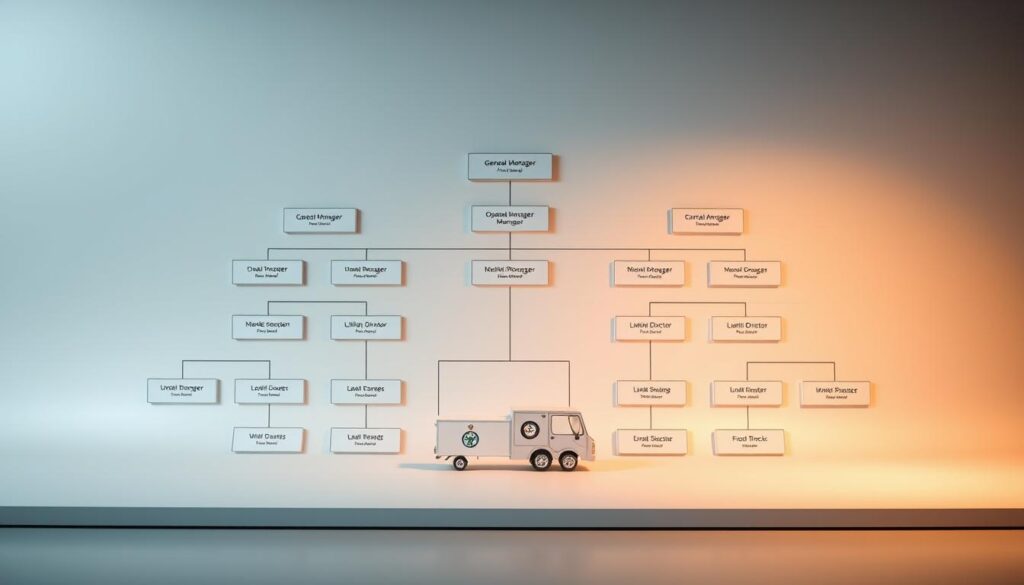Did you know that the mobile food service industry has seen a remarkable growth rate of over 7% annually, with food trucks generating an estimated revenue of $1.2 billion in the United States alone? This staggering statistic underscores the importance of a strategically crafted food truck business plan. As you embark on this exciting journey of mobile food business planning, it’s crucial to develop a comprehensive food truck business plan template that outlines your goals, operational strategies, and financial projections. A well-detailed plan not only serves as a roadmap for success but also attracts potential investors and helps navigate the competitive landscape of the food truck industry.
Key Takeaways
- A solid business plan is essential for food truck success.
- Understanding your concept is key to effective planning.
- Identifying your target market can enhance visibility and sales.
- Market analysis is crucial to stay ahead of competitors.
- Financial projections help in securing funding and guiding decisions.
Introduction to Food Truck Business Planning
Embarking on the journey of food truck planning can be both exciting and daunting. The food truck industry has become a noteworthy player in modern culinary culture, influencing trends and offering unique dining experiences. A robust food truck business setup is crucial for capitalizing on these opportunities. Before proceeding with significant investments, such as purchasing equipment or securing funding, it is essential to formulate a comprehensive plan.
A well-structured business plan serves as a roadmap, guiding you through the complexities of launching and operating a food truck. By clearly defining your brand, menu, and target audience, you set the stage for success. Embracing your culinary passion and aligning it with strategic planning can transform a simple food idea into a thriving venture.

Importance of a Business Plan for Your Food Truck
A well-crafted business plan holds significant importance for any food truck venture. It serves as a strategic roadmap leading entrepreneurs through the challenges of their business journey. The significance of business plan extends beyond documentation; it is a powerful tool that defines the operational framework, market strategies, and objectives of the enterprise.
The preparation of a business plan can be crucial for securing a food truck investment. Investors and lenders seek assurance that their financial backing will lead to a profitable outcome. By presenting a solid plan, food truck owners can effectively communicate their vision, anticipated challenges, and strategies for success.
Additionally, the business plan enables food truck operators to make informed decisions. With clearly defined goals and methodologies, owners can assess their progress and pivot when necessary. The structured approach to planning ensures long-term sustainability and growth, reinforcing the overall significance of a business plan.

| Aspect | Importance |
|---|---|
| Operational Framework | Provides a clear structure for daily operations. |
| Market Strategies | Identifies target markets and effective outreach methods. |
| Financial Projections | Helps estimate revenue, expenses, and profitability. |
| Risk Management | Identifies potential risks and outlines mitigation strategies. |
| Investor Confidence | Convincing investors of business viability and growth potential. |
Understanding Your Food Truck Concept
A well-defined food truck concept serves as the foundation for a successful venture in this competitive industry. Defining the elements of your food truck concept involves identifying the type of cuisine, the branding, and the unique design of the truck itself. This concept not only attracts customers but also creates a sense of identity that helps distinguish your business in a saturated market.
To thrive in a niche market, culinary differentiation is key. This means crafting a menu that showcases unique flavors or cooking styles, whether that’s inspired by ethnic dishes, seasonal ingredients, or local specialties. Understanding culinary trends can greatly benefit your food truck concept as it allows you to tap into current consumer preferences, ensuring your offerings resonate with potential customers.
When establishing your food truck concept, consider factors such as the truck’s aesthetic, your branding strategy, and how these elements enhance your brand message. Your unique selling propositions should focus on what sets you apart from competitors. Identifying these elements creates a cohesive narrative that can significantly enhance the appeal of your food truck business.

Defining Your Target Market
Identifying the food truck target audience is crucial for creating a successful business model. A comprehensive understanding of customer demographics, including factors such as age, income levels, and lifestyle choices, helps in tailoring menu offerings and marketing strategies. Various segments exist within the target market, and recognizing these can significantly enhance the overall customer experience.
For instance, younger consumers often seek out trendy and unique food options, while families may prioritize affordability and convenience. Seniors might prefer healthier options and comfortable seating. Having clear insights into these demographics allows food truck operators to design menus that resonate with each group.
Utilizing market research tools can offer a wealth of information. Surveys, social media analytics, and customer feedback play significant roles in gathering data about the food truck target audience. This information not only helps in menu customization but also improves marketing efforts and service approaches, ensuring they align with customer preferences.

Ultimately, investing time and resources into understanding customer demographics can lead to strategic advantages in a competitive market. By focusing on the unique needs and preferences of different segments, food truck businesses can enhance their profitability and foster brand loyalty.
Market Analysis: Identifying Trends and Competitors
Understanding the food truck market trends is essential for any budding entrepreneur in this industry. A thorough analysis reveals insights about customer preferences and potential growth areas. With the increasing popularity of food trucks, industry revenues are projected to rise significantly in the coming years, making it a lucrative venture for new businesses.
Analyzing the competitive landscape allows prospective food truck owners to identify key players in their desired markets. By studying existing competitors, entrepreneurs can determine their unique value propositions and strategize effectively. Successful food trucks often differentiate themselves through unique menus, branding, and customer engagement tactics.
| Trend | Description | Impact on Market |
|---|---|---|
| Health-Conscious Options | Increased demand for nutritious and organic foods. | Attracts health-oriented customers. |
| Mobile Ordering | Rise in apps for ordering ahead to streamline service. | Enhances customer convenience. |
| Local Sourcing | Preference for locally sourced ingredients. | Supports community engagement and sustainability. |
| Cultural Fusion Cuisine | Popularity of blending different culinary traditions. | Appeals to diverse customer tastes. |
In this vibrant ecosystem, leveraging market trends while keeping an eye on the competitive landscape provides a robust framework for success. By staying informed, food truck owners can adjust their strategies and refine their offerings to meet consumer demands effectively.

Creating a Food Truck Business Plan Template
Designing a comprehensive food truck business plan template serves as the blueprint for your culinary venture. This template allows entrepreneurs to outline their concept, target audience, market analysis, and financial projections. Each key section plays an essential role in effectively communicating your vision to potential investors or partners.
Key Sections of the Template
A well-structured template should include the following key sections:
- Executive Summary: A snapshot of your business and its objectives.
- Company Description: A detailed overview of your food truck, including its unique selling points.
- Market Analysis: Insight into your competitive landscape and market trends.
- Financial Projections: Estimates of revenue, expenses, and profitability.
How to Customize Your Template
Business plan customization is crucial for aligning your template with your specific food truck concept. Consider these steps:
- Identify your target audience’s preferences.
- Adjust marketing strategies based on local competition.
- Update financials to reflect realistic goals and costs.

Executive Summary: Laying the Groundwork
The food truck executive summary holds tremendous significance as it often serves as the initial impression for potential investors. A well-structured executive summary outlines essential details, presenting a concise business overview that captures interest and highlights the viability of the venture. Key components include the type of food to be offered, the anticipated market gap, projected costs, and profit potential.
Investors look for clarity and conciseness in this section. Outline the unique selling proposition of the food truck, detailing what sets it apart from competitors. The food truck executive summary should also express aspirations for growth and expansion, showcasing the long-term vision. It acts as a compass for the entire business plan, summarizing crucial aspects while enticing readers to explore further.
Although it appears first in the document, crafting this section usually occurs last. This approach ensures that the most critical insights from the entire planning process are included, solidifying the importance of presenting a compelling and informative food truck executive summary.

Company Description: Who Are You?
A comprehensive food truck company overview is essential for establishing a strong business identity. This section delves into the essence of the food truck, detailing its unique concept, ownership structure, and targeted consumer niche. Understanding these components offers insight into the competitive advantages that differentiate the business in a bustling market.
The concept of the food truck goes beyond just selling meals on wheels. It embodies a style, a cuisine, and a vibe that resonates with the local community. Whether focused on gourmet fusion, traditional comfort foods, or health-conscious options, pinpointing the niche is crucial for attracting the right customer base.
Ownership structure can vary greatly, from sole proprietorships to partnerships or even limited liability companies. Each structure brings distinct advantages and responsibilities, impacting everything from tax obligations to decision-making processes.
To illustrate the components of a food truck company overview, consider the following table that highlights essential attributes of a successful food truck business:
| Attribute | Description |
|---|---|
| Concept | Unique culinary offerings or themes that set the food truck apart. |
| Ownership | Type of legal structure (e.g., sole proprietorship, partnership). |
| Niche Market | Specific audience that the food truck aims to serve. |
| Competitive Advantage | Unique features that provide a market edge, such as specialty items or superior customer service. |
| Operational Format | Type of mobile food service (truck, cart, or trailer). |
Building a robust business identity hinges on seamlessly integrating these elements. A well-defined company description not only communicates the food truck’s mission but also highlights its contributions to the existing market, reinforcing the overall value proposition.

Market Analysis: Diving Deeper
Conducting an in-depth market analysis is crucial for any food truck entrepreneur aiming to succeed in a competitive food landscape. Understanding the market size and growth potential provides valuable insights into consumer demands and preferences. Recognizing seasonal trends can help in optimizing menu options and pricing strategies, ensuring alignment with customer expectations.
Assessing barriers to entry is equally important. These factors can significantly impact how easily new players can enter the market. Entrepreneurs should consider regulatory requirements, initial capital investment, and location-specific challenges that might affect their venture.
A thorough evaluation of the competitive food landscape reveals not just direct competitors but also potential allies in the industry. Identifying strengths and weaknesses of existing food trucks allows for informed decisions on branding, marketing, and service offerings.

| Market Aspect | Details |
|---|---|
| Market Size | Roughly $2 billion in annual revenue for food trucks in the U.S. |
| Growth Rate | Expected growth of 7.5% annually over the next 5 years. |
| Consumer Preferences | Increasing demand for organic and locally sourced offerings. |
| Typical Pricing Strategy | Prices range from $8 to $15 for most items. |
| Barriers to Entry | Health regulations, permit requirements, and capital costs. |
Organization and Management Structure
Establishing a clear organizational plan is essential for the success of a food truck business. A well-defined food truck management team not only delineates roles and responsibilities but also enhances operational efficiency. This management structure helps ensure that everyone understands their function within the team, contributing to streamlined operations and improved service delivery.
Identifying Key Roles
Understanding the specific roles within the food truck management team fosters accountability and collaboration. Typical roles include:
- Owner/Operator: Manages overall operations and strategic direction.
- Chef: Responsible for menu preparation and food quality.
- Marketing Manager: Focuses on social media strategy and promotional events.
- Customer Service Representative: Engages with customers to ensure satisfaction.
An organizational chart can visually represent these roles, simplifying communication and defining reporting structures.
Legal Structure of Your Food Truck
Choosing the appropriate legal structure is a critical step for your food truck. Major options include:
- Sole Proprietorship: Simplest form, where one individual owns the business.
- Partnership: Shared ownership between two or more individuals.
- Limited Liability Company (LLC): Combines benefits of a partnership and corporation, offering liability protection.
The chosen legal structure impacts financial liability, tax obligations, and regulatory compliance. Evaluating these factors ensures that your food truck operates within the legal framework while allowing for optimal business growth.

| Role | Responsibilities |
|---|---|
| Owner/Operator | Overall management, business strategy, and finances |
| Chef | Menu development and food preparation |
| Marketing Manager | Promotions, branding, and social media |
| Customer Service Representative | Customer interaction and satisfaction monitoring |
Service or Product Line: Your Menu Offerings
Crafting a successful food truck menu strategy is vital for attracting customers and establishing a unique brand identity. A well-curated selection of product offerings can distinguish a food truck in a competitive market. Identifying signature dishes that reflect culinary trends and target audience preferences enhances the overall appeal.
When developing menu items, consider incorporating local ingredients and flavors that resonate with the community. This connection can foster brand loyalty while appealing to a wider audience. Pricing structures should remain competitive yet reflect the quality and creativity of the food. Regularly reassessing pricing allows for adjustments based on ingredient costs and market demand.

Efficient food preparation processes contribute to a smooth operation and an outstanding customer experience. Streamlining these processes ensures that the food truck can serve high-quality meals quickly, satisfying customer expectations. Customers appreciate transparency about how their food is prepared, fostering trust and encouraging repeat business.
To summarize, a comprehensive approach to your food truck menu strategy, encompassing diverse product offerings and effective operational practices, sets the foundation for long-term success in the food truck industry. Constantly evolving the menu in response to customer feedback and trends can keep the food truck vibrant and appealing.
Marketing and Sales Strategies for Success
Successful food truck marketing hinges on understanding customer desires and aligning business strategies to meet those needs. Engaging promotional tactics like social media campaigns can effectively draw potential customers. Utilizing platforms such as Instagram and Facebook allows food trucks to showcase their unique offerings and create enticing visuals that attract followers.
Participating in local events can further enhance visibility. Festivals, markets, and community gatherings provide the perfect stage for food trucks to engage with a diverse audience. It’s essential to tailor participation based on the target demographic, ensuring that the truck’s identity resonates with event-goers.
Forming partnerships with local businesses can augment sales growth strategies. Collaborating with breweries for food and beer pairings or offering catering services for local gatherings can open new revenue streams. Strong partnerships not only foster community engagement but can also enhance brand loyalty.
A solid online presence remains indispensable in today’s market. Websites should be mobile-friendly, showcasing the menu, location, and operating hours. Regular updates on social media about special deals or menu changes keep customers informed while encouraging them to visit the truck more frequently.
In summary, effective food truck marketing integrates innovative promotional strategies with robust online engagement and community-focused partnerships, all of which work together to create significant sales growth strategies.

Funding Request: How Much Do You Need?
Understanding your food truck funding needs is vital for a successful venture. This involves assessing both initial investment costs and ongoing expenses necessary for operations. A well-articulated funding request can draw the interest of potential investors or lenders. Clarity in your financial ask showcases your preparedness and business acumen.
Begin with a comprehensive overview of expected costs. Categories to consider include vehicle purchase or leasing, equipment, permits, and initial inventory. Factor in operational expenses such as staffing, marketing, and maintenance costs. By presenting a detailed breakdown, you provide transparency that enhances credibility, a crucial element when evaluating investment considerations.
Here’s a sample breakdown:
| Expense Category | Estimated Cost |
|---|---|
| Food Truck Purchase/Lease | $50,000 |
| Equipment (Grills, Freezers, etc.) | $15,000 |
| Permits and Licenses | $5,000 |
| Initial Inventory | $2,000 |
| Marketing Expenses | $3,000 |
| Staffing Costs for First 3 Months | $12,000 |
| Miscellaneous Expenses | $5,000 |
Total funding request: $92,000. This figure conveys the complete scope of your food truck funding needs, ensuring potential investors or lenders understand what their funds will support. A robust funding strategy not only aids in initial startup but also positions the business for growth and success.

Financial Projections: Forecasting Your Business Success
Creating accurate food truck financial forecasts involves multiple facets of your business plan. This analysis helps in determining profit margins, estimating cash flow, and evaluating operational costs. Effective budgeting for food truck operations is not merely guesswork; it requires thorough research, market understanding, and historical financial data, if available.
Start by calculating expected revenues based on your pricing strategy and anticipated customer volume. Consider different scenarios such as peak seasons and special events that may boost sales. Use these estimates to generate a clear cash flow forecast, allowing you to plan for lean periods and unexpected expenses.
Next, account for operational costs, which could include food supplies, staff wages, permits, and maintenance. It’s essential to differentiate between fixed and variable costs in your projections. Fixed costs remain constant regardless of sales, while variable costs may fluctuate with business activity.
Here’s a brief overview in table format:
| Item | Estimated Monthly Cost |
|---|---|
| Food Supplies | $2,500 |
| Staff Wages | $3,000 |
| Permits and Licenses | $500 |
| Fuel and Maintenance | $600 |
| Marketing and Promotions | $400 |
| Total Costs | $7,600 |
In this context, financial forecasts become indispensable for justifying funding requests or attracting investors. A well-documented budget reinforces your proposal’s credibility by showcasing a solid understanding of your food truck’s financial landscape. Accurate and realistic financial projections pave the way for sustainable growth and profitability.

Appendix: Supporting Documents and Information
A comprehensive food truck appendix serves as an essential component of your business plan. This section houses important supplementary information that strengthens the foundation of your proposal. Including this appendix lends credibility to your food truck venture, allowing potential investors and stakeholders to understand the operational aspects better.
When compiling your food truck appendix, consider incorporating various documents such as:
- Business licenses and permits
- Supplier agreements
- Market research data
- Financial statements
- Sample menu designs
By presenting these documents, you offer a transparent view of your business’s structure and operational plan. This supplementary information not only affirms your commitment to the food truck industry but also highlights your readiness and professional acumen for prospective ventures.

Ensure that each document in your food truck appendix is clearly labeled and organized for easy navigation. A well-structured appendix can significantly enhance the persuasive power of your business plan, leading to more fruitful discussions with potential investors.
Conclusion
In the dynamic world of food trucks, successful food truck business planning stands as a cornerstone for long-term success. A well-structured business plan provides not only a roadmap for your operations but also a strategic tool that keeps you aligned with your goals. It encompasses various aspects from market understanding to financial forecasting, ensuring that you remain competitive in a bustling industry.
As you pave your way in this entrepreneurial journey, take the time to revisit your business plan regularly. This practice is crucial for reassessing your goals and adjusting your strategies as necessary. By taking these vital next steps, you can position your food truck for ongoing improvement and resilience, adapting to market changes while enhancing your overall service.
Ultimately, the commitment to refining your business plan will empower you to navigate the complexities of the food truck market more effectively. Remember, success is not just about having a great menu; it’s about a holistic approach that integrates planning, execution, and continuous improvement.









